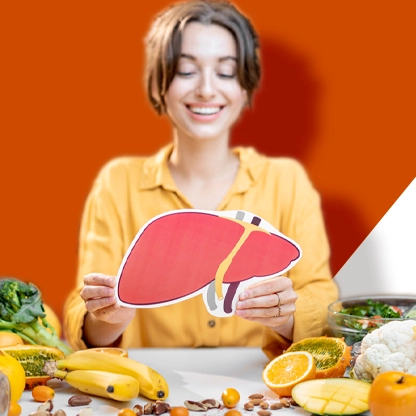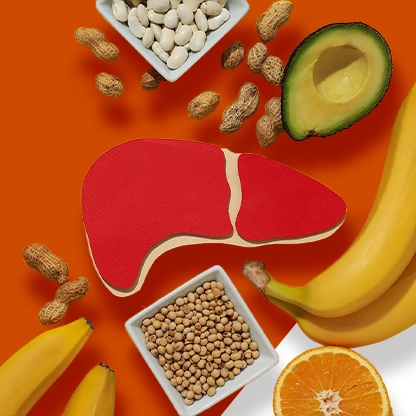.webp)
Article summary
Topic
We present the facts and dispel the myths about the liver and its functions.
Facts
Yes, it is. A vast majority of medicines are metabolized in the liver, which may in some cases result in an injury to liver cells (hepatocytes). In such a case, we talk about drug-induced liver injury.1 Using excessive drug doses and taking multiple drugs that may mutually affect their metabolism at the same time may prove dangerous for your liver.1 One of the commonly used medicines that are potentially hepatotoxic is acetaminophen (paracetamol). It is available in single-ingredient medicines and in many fixed-combination medicines, hence the high risk of an overdose. You should remember that the maximum allowable daily dose of this compound (contained in painkillers and common cold remedies) is 4000 mg for adults.2 Liver injury symptoms may already be caused by taking only twice the maximum recommended daily dose.2
That is correct. In fact, glucose-fructose syrup that is commonly added to drinks and other highly processed food products is particularly dangerous to the liver. That syrup contains a large amount of fructose, which is absorbed by the liver in 99% and stimulates that organ to produce adipose tissue. Clinical observations indicate that there is a relationship between the consumption of glucose-fructose syrup and the incidence of non-alcoholic fatty liver disease.7
Yes, it is. NAFLD is currently considered a disease of affluence. It is estimated that already every fourth adult person may be affected by that disease. On the global scale, as much as one billion people are estimated to live with NAFLD! In the United States, NAFLD is the most common cause of chronic liver disease that affects between 80 and 100 million people, nearly 25% of whom develop its more acute form – NASH.9 Non-alcoholic fatty liver disease (NAFLD) is the most prevalent liver disease in the world, and NASH is predicted to soon become the top indication for liver transplantation.9
Yes, but it is not its only task. The liver is a true master of multitasking. You can find more information about all its functions that are necessary for the proper functioning of the whole body here:
Yes, that is correct. Because of the absence of nerves, the liver does not generate pain. However, as a result of many different diseases, the liver may become enlarged, compressing its enveloping peritoneum, called Glisson’s capsule. Glisson’s capsule has sensory innervation, which is why its tension may cause a sensation of pressure or even pain.3
Yes, that is correct. A diet that is friendly to the liver is easily digestible, with a limited amount of fats, sugars and salt. Fried foods and fast foods should be avoided. The diet should be well balanced – it should contain foods from all groups: cereal products, vegetables, fruits, dairy products, meat, and oils. It is very important to drink water and limit the consumption of alcohol.4
Nevertheless, it should be borne in mind that the diet of a patient with liver disease should be selected individually, taking into account the patient’s nutritional status and requirements of the patient’s body.
For more information on the healthy liver diet, go to this article:
Accelerate liver regeneration with Phospholipids (Essentiale® Forte P)
Myths
Liver cancer is a disease that is strongly related to pre-existing hepatic cirrhosis. Therefore, the risk factors for liver cancer are the factors that cause cirrhosis. Chronic infection with hepatitis B or C virus is one of the strongest risk factors. Chronic hepatitis B and C is estimated to be responsible for 50% and 25% of liver cancer cases, respectively. Excessive alcohol intake is also listed as one of important factors that predispose to liver cancer.16
No, not always. Yellowing of the skin and eye whites is only one of a whole array of symptoms of viral hepatitis and does not always have to be present. It is estimated that among patients with viral hepatitis there are 5 to 15 persons without jaundice per each person with this symptom.17,18
Unfortunately, it is not. A lifestyle change is as important as pharmacological treatment. Primarily, a change in eating habits is necessary – you should avoid fats of animal origin, limit the intake of simple sugars (e.g. sweets), abstain from sweetened drinks, it is also recommended to avoid hot spices and bloating foods (cabbage, onions, pulses, asparagus, plums, pears, sweet cherries).11 It is good to start regular physical activity that facilitates weight loss and increases insulin sensitivity.12
The source of phospholipids can be a well-balanced diet. Products rich in phosphatidylcholine – the most important phospholipid – include egg yolk, liver, soybean, peanuts, asparagus, and oat flakes. However, bad eating habits may interfere with phosphatidylcholine absorption from food products. In such cases, it is necessary to supplement the diet with phospholipids obtained from soybean. Products containing soybean phospholipids are a source of phosphatidylcholine rich in omega-6 acids.19
For more information about phospholipids, go to:
No, that is not true. Non-alcoholic fatty liver disease (NAFLD) is the most common liver disease in the developed countries. What is more, its prevalence continues to increase, which correlates with the increasing incidence of obesity and diabetes. As evidenced by research studies, NAFLD affects over a half of persons living with type 2 diabetes and 70% of obese persons.20
You can find more information about fatty liver here:
No, they are not. An excessive consumption of alcohol is a very strong risk factor but not the only cause of liver diseases. Liver function impairment may also be caused by other factors such as viral hepatitis (caused by hepatitis B and C viruses) and the metabolic syndrome (abnormal metabolism related to such conditions as overweight and obesity).10
It is high time to dispel this myth – studies demonstrate the multiple advantages of drinking coffee in the context of liver health. Coffee has been demonstrated to have a positive effect on liver enzymes, the level of fattening and fibrosis of the liver, and the risk of cirrhosis.14,15 However, there are a few rules of drinking coffee that are worth knowing – you may read about them here:
Weight loss is beneficial for liver function but only when it is not too drastic or too quick. Weight reduction by 10% within 3 to 6 months brings an improvement of the health condition – but it must occur according to a schedule, i.e. by about 1 kg per week.13
Any draconian diets aiming for a rapid rate of weight loss are usually not durable, and also may cause a rapid release of large amounts of fats into the bloodstream, with the consequential fattening of the liver. The so-called monotrophic diets, where nutrients from almost exclusively one product group are delivered to the body, will also not help your liver. An example is the popular Dukan’s diet, where excessive ingestion of proteins has a negative effect on liver health.13
- Gutkowski K et al. Hepatotoxicity of drugs - causative mechanisms. Gastroenterological Review 2008; 3 (6): 271–275.
- MP Drug Index - description of the substance paracetamol. http://indeks.mp.pl/leki/desc.php?id=631 - DOA: 16/11/2016.
- Damjanov I. Diseases of the liver and biliary tract. In: Pathophysiology. Issue 1. Elsevier Urban & Partner. Wroclaw 2010: 273–278.
- American Liver Foundation, A Healthy Diet, a Healthier Liver, a Healthier You https://liverfoundation.org/for-patients/about-the-liver/health-wellness/nutrition/ - access date: 29/03/2021.
- Mokrowiecka A. The liver and fat-soluble vitamins. http://gastrologia.mp.pl/lista/64073 , liver-and-vitamins-fat-soluble. - DOA: 2016.10.16.
- Bojarowicz H et al. The effect of vitamin A on the condition of the skin. Probl Hig Epidemiol 2010; 91 (3): 352–356.
- Wolańska D. Glucose-fructose syrup and its influence on health http://dieta.mp.pl/zasady/118347 , glucose-fructose-syrup-and-his-health-impact. –DOA: 2016.10.16.
- Mokrowiecka A. Liver transplant. Gastrology - Practical Medicine; https://www.mp.pl/pacjent/gastrologia/choroby/watroba/74668 , transplant-watarzenia DOA: 2016.10.16 accessed on 09.05.2021
- Perumpail, BJ, Khan, MA, Yoo, ER, Cholankeril, G., Kim, D., & Ahmed, A. (2017). Clinical epidemiology and disease burden of nonalcoholic fatty liver disease. World Journal of Gastroenterology, 23 (47), 8263-8276
- Blachier M et al. The burden of liver disease in Europe: A review of available epidemiological data. J Hepatol 2013; 58: 593–608.
- Jaczewska-Schuetz J. Nutrition in liver diseases. http://dieta.mp.pl/diety/diety_w_chorobach/72098,zywanie-w-chorobach-watrawy . - DOA: 2016.10.15.
- Kargulewicz A et al. Nonalcoholic fatty liver disease - Etiopathogenesis, epidemiology, treatment. Nowiny Lekarskie 2010; 79: 410–418.
- Olszanecka-Glinianowicz M. Dukan's diet. http://dieta.mp.pl/diety/diety_alternacyjne/66570,dieta-dukana . - DOA: 2016.10.16
- Morisco F. et al. Coffee and liver health; J Clin Gastroenterol 2014; 48: S87 – S90 https://journals.lww.com/jcge/Fulltext/2014/11001/Coffee_and_Liver_Health.24.aspx accessed on May 9, 2021
- Jarosz M. KAWA - a rising star of disease prevention? Food and Nutrition Institute; September 2018.http://www.izz.waw.pl/attachments/article/633/KAWA_NEWSLETTER__IZ%CC%87Z%CC%87.pdf accessed on May 9, 2021
- European Society of Medical Oncology; Liver cancer: a guide for patients - Information based on ESMO Clinical Practice Guidelines - v. 2014.1; https://www.esmo.org/content/download/102688/1814031/file/PL-Rak-Wa%CC%A8troby-Poradnik-dla-Pacjento%CC%81w.pdf accessed on 09.05.2021
- Juszczyk J, Pawłowska M. Acute viral hepatitis (viral hepatitis). http://gastrologia.mp.pl/choroby/watroba/50949,ostre-wirusowe-zaprzenie-watarzenia-wzw . - DOA: 2016.10.16
- CDC Viral hepatitis https://www.cdc.gov/hepatitis/hcv/hcvfaq.htm#b1 access on 09/05/2021
- Kozłowska-Wojciechowska M. Essential phospholipids; Therapy - in the family doctor's office, June 2014 https://terapia.com.pl/publ/id , 137491, ed, 267 accessed on 09/05/2021
- Gietka J. Klapaczyński J., Fatty liver disease - diagnosis and treatment, https://podyawodie.pl/medycyna/23439,stluszczenie-watrawy-diagnostyka-i-leczenie , accessed on 29/03/2019.
%20(1)%20(1).webp)
.webp)


